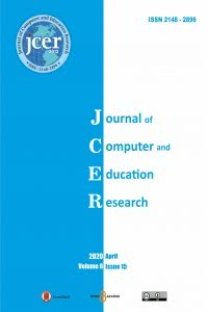Ortaokul Öğrencilerinin Grafik Algıları ve Grafik Oluşturma Yeterlikleri: Bir Durum Çalışması
Bu araştırmada sekizinci sınıf öğrencilerinin grafik algılarının ve grafik oluşturma yeterliklerinin incelenmesi amaçlanmaktadır. Araştırmanın yöntemi durum çalışması olup veri toplama aracı olarak klinik görüşme görevleri kullanılmıştır. Araştırmanın çalışma grubunu akademik başarıları yüksek beş öğrenci oluşturmaktadır. Elde edilen veriler nitel veri analizi yöntemlerine göre analiz edilmiştir. Araştırmanın sonucunda, grafik algısı teorik çatısı bağlamında sekizinci sınıf öğrencilerinin veri okuma düzeyinde herhangi bir sorun yaşamadıkları fakat üst düzey beceriler gerektiren veriler arası okuma ve veri ötesi okuma düzeyindeki beceriler noktasında zorluklar yaşadıkları tespit edilmiştir. Ayrıca öğrencilerin grafik eksenlerinin ölçeklendirilmesi, eksenlerin adlandırılması, verilen noktalardan geçen doğrusal grafiği çizme ve uygun grafik türüne karar verme gibi bir takım zorluklarla karşılaştıkları ve bu noktada yanılgılara sahip oldukları görülmüştür.
Anahtar Kelimeler:
Grafik algısı, grafik anlama, grafik oluşturma, veri işleme, ortaokul öğrencisi
Middle School Students’ Making Sense of Graph and Graph Comprehension Competencies: A Case Study
In this study, it is aimed to examine eighth grade students' making sense of graph and graph comprehension competencies. The research method is a case study and clinical interview tasks was used as a data collection tool. The study group consisted of five students with high academic achievement. The data obtained were analyzed according to qualitative data analysis methods. As a result of the study, it was determined that eighth grade students did not have any problems at the level of data reading in the context of the theoretical framework of making sense of graph, but they had difficulties on reading between the data and reading beyond the data, which require higher level skills. Besides students encountered some difficulties such as scaling the graph axes, naming the axes, drawing a linear graph passing through the given points and deciding on the appropriate graph type and had misconceptions at this point.
Keywords:
Graph sense, graph comprehension, data processing, middle school student,
___
- Aliaga, M., Cobb, G., Cuff, C., Garfield, J., Gould, R., Lock, R., Moore, T., Rossman, A., Stephenson, B., Utts, J., Velleman, R., Witmer, J. (2005). Guidelines for assessment and instruction in statistics education (GAISE) college report. Retrieved July 07, 2019, from http://www.amstat.org/education/gaise/
- Baki, A. (2015). Kuramdan uygulamaya matematik eğitimi. Ankara: Harf Eğitim Yayıncılık.
- Bayazıt, İ. (2011). Öğretmen adaylarının grafikler konusundaki bilgi düzeyleri. Gaziantep Üniversitesi Sosyal Bilimler Dergisi, 10(4), 1325 -1346.
- Curcio, F.R. & Artzt, A.F. (1997). Assessing students’ statistical problem solving behaviours in a small group setting. In I. Gal ve J.B. Garfield (Eds.), The assessment challenge in statistics education (pp. 123–138). Amsterdam, The Netherlands: IOS Press.
- Diaz-Levicoy, D., Batanero, C., Arteaga, P., & Gea, M. M. (2019). Chilean children’s reading levels of statistical graphs. International Electronic Journal of Mathematics Education, 14(3), 689-700. http://doi.org/10.29333/iejme/5786
- Friel, S., Curcio, F. & Bright, G. (2001). Making sense of graphs: critical factors influencing comprehension and instructional implications. Journal for Research in Mathematics Education, 32(2), 124- 158.
- Hattikudur, S., Prather, R. W., Asquith, P., Alibali, M. W., Knuth, E. J., Nathan, M. (2012). Constructing graphical representations: middle schoolers' intuitions and developing knowledge about slope and y-intercept. School Science and Mathematics, 112(4), 230-240. http://doi.org/10.1111/j.1949- 8594.2012.00138.x
- Kwon, O. N., Park, J. H., & Park, J. S. (2006). Cultivating divergent thinking in mathematics through an openended approach. Asia Pacific Education Review, 7(1), 51-61.
- Lai, K., Cabrera, J., Vitale, J. M., Madhok, J., Tinker, R., & Linn, M. C. (2016). Measuring graph comprehension, critique, and construction in science. Journal of Science Education and Technology, 25(4), 665-681.
- Leinhardt, G., Zaslavsky, O., & Stein, M. K. (1990). Functions, graphs, and graphing: Tasks, learning, and teaching. Review of Educational Research, 60(1), 1-64.
- McKnight, C. C. (1990). Task analyses of critical evaluations of quantitative arguments: First steps in critical interpretation of graphically presented data. In G. Kulm (Eds.), Assessing higher order thinking in mathematics (pp. 169-185). Washington, DC: American Association for the Advancement of Science.
- Milli Eğitim Bakanlığı [MEB] (2009). Matematik dersi öğretim programı (1, 2, 3, 4, 5, 6, 7 ve 8. sınıflar). Ankara: MEB.
- Milli Eğitim Bakanlığı [MEB] (2018). Matematik dersi öğretim programı (1, 2, 3, 4, 5, 6, 7 ve 8. sınıflar). Ankara: MEB.
- Miles, M, B., & Huberman, A. M. (1994). Qualitative data analysis: An expanded sourcebook. (2nd ed). Thousand Oaks, CA: Sage.
- Monteiro, C. & Ainley, J. (2003, February). Developing critical sense in graphing. proceedings of III conference of the european society for research in mathematics education (CERME).
- Monteiro, C. & Ainley, J. (2007). Investigating the interpretation of media graphs among student teachers. International Electronic Journal of Mathematics Education, 2(3), 187- 207.
- National Council of Teachers of Mathematics (Ed.). [NCTM] (2000). Principles and standards for school mathematics: A guide for mathematicians. Notices of the american mathematical society, 47(8), 868-876.
- Stake, R. E. (1995). The art of case study research. Thousand Oaks, CA: Sage.
- Tan, M. & Temiz, B. K. (2009). Lise 1. sınıf öğrencilerinin grafik yorumlama becerileri, Selçuk Üniversitesi Ahmet Keleşoğlu Eğitim Fakültesi Dergisi, 28, 31-43.
- Tosun, T. & Özen-Ünal, D. (2019). Veri ve olasılık öğrenme alanlarında yapılmış çalışmaların içerik analizi. Ege Eğitim Dergisi, 20(1), 244-261.
- Yıldırım, A. & Şimşek, H. (2008). Sosyal bilimlerde nitel araştırma yöntemleri (6. Baskı). Ankara: Seçkin Yayıncılık.
- Wainer, H. (1992). Understanding graphs and tables. Educational Researcher, 21(1), 14-23.
- Yayın Aralığı: 2
- Başlangıç: 2013
- Yayıncı: Tamer KUTLUCA
